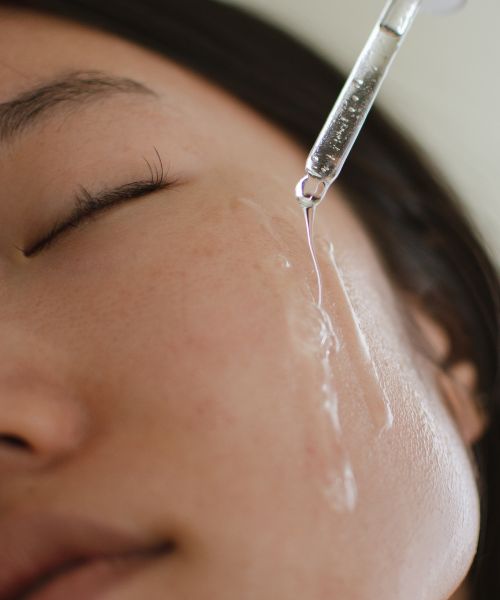Hyaluronic acid is a master humectant and one of the most popular ingredients found in modern skincare products.
Available in anything from cleansers, toners, serums, and moisturizers, this hydrating ingredient can address multiple skin concerns and improve skin’s general health and appearance.
Hyaluronic acid can even be used for acne, and due to its mild anti-inflammatory properties, it can help soothe inflammation and act as a supporting ingredient in an acne-fighting regimen.
However, like with any other ingredient in skincare products, hyaluronic acid can damage the skin, especially when used incorrectly.
Therefore, in this article, I will explain what hyaluronic acid is and how it works and provide tips on how to use this hydrating powerhouse for optimal results and no side effects.

What is Hyaluronic Acid & How Does it Work?
Hyaluronic acid is a naturally occurring substance that plays several vital roles in our bodies.
Firstly, it helps regulate cell proliferation and differentiation, which can influence how cells grow and develop. This is particularly important in tissue repair and wound healing, where hyaluronic acid can help stimulate the growth of new cells and tissues.
Hyaluronic acid also plays a crucial role in maintaining the extracellular matrix – a network of proteins and other molecules that provide structural support to cells. Specifically, hyaluronic acid binds water molecules in the extracellular matrix, creating a gel-like structure that can absorb shock and cushion cells. This is especially important in areas of the body that experience a lot of wear and tear, such as joints and cartilage.
Another way that hyaluronic acid works on a cellular level is by interacting with other molecules in the body. For example, it can bind to specific receptors on the surface of cells, which can trigger various signaling pathways and affect cellular behavior.
Additionally, hyaluronic acid is essential for skin health, as it makes up about 50% of all glycosaminoglycans (GAGs), which are large molecules known as polysaccharides that deal with the support and maintenance of structural proteins such as collagen and elastin, which are essential for maintaining skin health and appearance.
Overall, hyaluronic acid is a highly versatile and essential molecule that plays many different roles on a cellular level. Whether regulating cell growth and differentiation, maintaining the extracellular matrix, or interacting with other molecules in the body, hyaluronic acid is an essential component of healthy cellular function.
However, despite naturally having abundant hyaluronic acid, we can also use it in a topical form by applying skincare products such as toners, serums, and moisturizers that contain this ingredient directly to our skin.
As a powerful hydrator and a humectant that can attract water from the surrounding environment and draw it into the skin, topically applied hyaluronic acid can help the skin retain moisture better and make it look smoother, plumper, and healthier.
In addition to its hydrating properties, some types of hyaluronic acid found in topical products have been shown to have anti-inflammatory effects, which can help reduce redness and irritation in the skin. It also has antioxidant properties, which can help protect the skin from damage caused by free radicals and environmental stressors.
The Benefits of Using Hyaluronic Acid
Using hyaluronic acid in your skincare routine can provide many benefits for your skin.
Firstly, it’s a powerful hydrator that can attract and retain moisture in the skin, making it appear plumper, smoother, and more youthful. This is particularly beneficial for those with dry or dehydrated skin, as it can help restore the skin’s natural moisture balance.
Additionally, hyaluronic acid can also help improve the appearance of fine lines and wrinkles. This is because as we age, our skin naturally loses some of its ability to retain moisture, which can lead to the development of these prominent skin concerns. By using hyaluronic acid, we can help counteract the effect of aging on the skin and keep it looking more youthful and healthy.
Hyaluronic acid also has anti-inflammatory and antioxidant properties, which can help reduce redness and irritation in the skin and protect the skin from damage caused by environmental stressors. This makes it an excellent ingredient for those with sensitive or reactive skin.
Furthermore, using hyaluronic acid can help improve the overall texture and tone of the skin. By providing the skin with a boost of hydration and promoting cellular renewal, it can help smooth out rough or uneven skin, reduce blotchiness, and even out skin tone.
Overall, hyaluronic acid is a highly versatile ingredient that can benefit the skin. Whether you’re looking to hydrate dry skin, reduce the appearance of fine lines and wrinkles, or improve your skin’s overall appearance and health, incorporating hyaluronic acid into your skincare routine is worth considering.
Can You Use Hyaluronic Acid for Acne?

Hyaluronic acid can be used on acne-prone skin, as it is a hydrating ingredient that can help the skin better retain moisture, thus strengthening its barrier and reducing inflammation.
However, hyaluronic acid won’t have the same effect on acne as some acne-fighting ingredients, such as benzoyl peroxide or salicylic acid, will.
These ingredients are designed to directly target breakouts by attacking the overgrowth of acne-causing bacteria and unclogging pores, whereas hyaluronic acid is more focused on improving skin hydration and replenishing moisture levels in the skin rather than actively fighting the multiple components that are causing this inflammatory condition.
This doesn’t mean hyaluronic acid can’t be used to help treat acne; however, it is more of a supporting ingredient in an overall acne-fighting skincare routine rather than a primary acne treatment.
Can Hyaluronic Acid Cause Acne?
Although hyaluronic acid is a non-inflammatory component, it can cause acne under several circumstances.
This can happen when misusing hyaluronic acid, such as using too much product or too frequently, which can irritate the skin and exacerbate inflammation, potentially leading to inflammatory skin conditions such as acne.
Additionally, hyaluronic acid can also dry out the skin when used incorrectly, which can trigger the oil-producing glands into secreting more oil to compensate for the dryness, but unfortunately, this oil can get stuck inside the pores unable to push through the skin’s surface due to the sheer volume, clogging them and attracting acne-causing bacteria.
Finally, using hyaluronic acid products that contain other potentially clogging ingredients that can block the pores can be another factor of hyaluronic acid causing acne in some people, even though the issue isn’t the main active ingredient, per se.
Therefore, it’s always important to check the product’s ingredient list you are interested in trying, as this can help you determine whether your unique concern and skin type can benefit from it.
In conclusion, while hyaluronic acid is one of the safest ingredients found in modern skincare products, it still can cause some unwanted effects, which is why using it correctly and with caution, as you would any other product, is essential to achieving optimal results without side effects.
What are the Side Effects of Using Hyaluronic Acid?
The two main side effects of hyaluronic acid are dryness and irritation due to incorrectly using the otherwise beneficial component.
The first way of using hyaluronic acid incorrectly is using it too frequently as this ingredient is naturally degraded every 24-48 hours by an enzyme called hyaluronidase, therefore using a hyaluronic acid serum more than once a day can be too much and irritate the skin as a result.
The second incorrect way to use hyaluronic acid is by applying more than a few drops of the ingredient in your skincare routine. This component is extremely common in skincare products, and chances are that you are already overusing it if your routine consists of several products that contain it.
Therefore, if you are going to add a hyaluronic acid serum to the mix, make sure to use it sparingly and no more than a few drops, as too much of this ingredient can cause skin dryness and irritation.
Finally, the third incorrect way to use hyaluronic acid is not to follow up the ingredient with an emollient-based moisturizer if you use it in a serum form.
This method of usage can leave the skin dry and irritated because hyaluronic acid needs to be sealed with components that create a barrier on the skin’s surface and prevent moisture from evaporating, leading to further hydration loss.
In conclusion, while hyaluronic acid is generally safe and tolerated by even the most sensitive and reactive skin, using it incorrectly can cause side effects, which is why knowing how to use it and when is key to achieving the desired results.
How to Use Hyaluronic Acid Correctly?

Here are three essential steps to ensure you are using hyaluronic acid correctly and making the most out of this hydrating component:
Use a Hyaluronic Acid Serum Once a Day
If you incorporate a hyaluronic acid serum into your skincare routine, using it once daily as part of your morning or evening routine is more than enough.
As I already mentioned, hyaluronic acid can stick around for at least 24 hours after applying it to the skin; therefore, using it once a day will not only make the product last longer but will give you optimal results without potentially irritating your skin.
Apply Hyaluronic Acid to Damp Skin
The best way to make the most of your hyaluronic acid product is to apply it to damp skin.
Hyaluronic acid works by drawing moisture from the surrounding environment and into the skin; therefore, applying it to dry skin can actually pull water from deeper layers, which can cause dryness and irritation.
On the other hand, applying hyaluronic acid to damp skin will create an environment for the ingredient to draw moisture out of, which can help increase its effectiveness.
To apply hyaluronic acid to damp skin, make sure your skin is cleansed and left to dry slightly on its own. Then while the skin is still damp and not fully dry, follow up with your hyaluronic acid toner, serum, or moisturizer to get the most out of this hydrating ingredient.
Follow Up With a Moisturizer
If you are using hyaluronic acid in a toner or serum form, you should always follow up with a moisturizer to seal the hydrating effect instead of allowing it to evaporate.
Therefore, after applying hyaluronic acid, and while the skin is still damp from the previous product, use an emollient-based moisturizer for maximum effect.

My name is Simone and I am a certified skin specialist. I created this website to teach my readers how to take great care of their skin and I also like to occasionally share my honest opinions on skincare products I’ve tried. You can learn more about me here.
